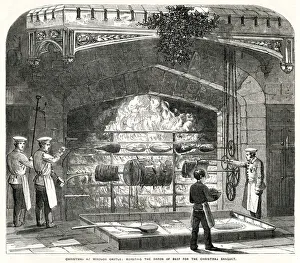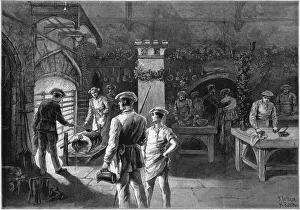Turnspit Collection
In the bustling kitchen of Windsor Castle, a tradition was upheld during the Christmastide Festival in 1900
All Professionally Made to Order for Quick Shipping
In the bustling kitchen of Windsor Castle, a tradition was upheld during the Christmastide Festival in 1900. The baron of beef, fit for royalty, was carefully roasted over an open fire in the grand fireplace. This annual event brought warmth and joy to all who attended. The aroma of succulent meat filled the air as guests eagerly awaited their feast. It was a spectacle that had been cherished for decades, dating back to 1856 when Christmas at Windsor Castle first saw this magnificent roast. A turnspit diligently worked by turning a wheel attached to the spit, ensuring even cooking and perfect browning. This engraving captured their tireless efforts as they tirelessly rotated the meat above crackling flames. Amongst these dedicated workers were turnspit dogs - short-legged breeds specially bred for this purpose. Their loyalty and strength were unmatched as they tirelessly ran within wheels, assisting in roasting processes like those seen in Newcastle Inn at Carmarthen, Wales around 1800. Cecil Aldin's illustrations from "Merry and Bright" beautifully depicted these hardworking canines with wagging tails and determined expressions on their faces. These loyal companions played an integral role in culinary history. As time passed, advancements replaced traditional methods with modern technology; however, memories of turnspits remained etched into history books. Line engravings from the 19th century showcased four tunspit dogs working together harmoniously - a testament to their importance throughout generations. Though no longer needed today due to technological progressions in cooking techniques, we must remember these unsung heroes who once served alongside chefs at prestigious events like roasting feasts fit for kings at Windsor Castle during Christmas celebrations long ago.

















